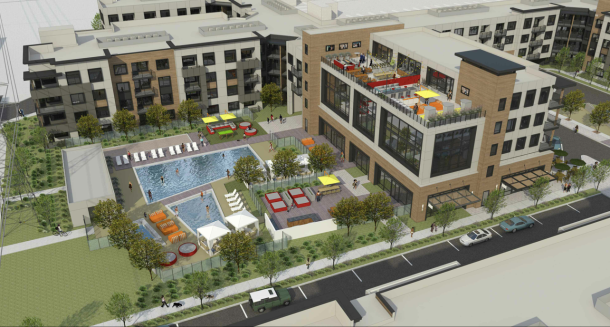Company housing has bad historical precedents and worse contemporary examples.
Facebook revealed plans Wednesday to build a $120 million, 394-unit housing community near its Menlo Park, California, offices. The development, named Anton Menlo, will in part address the housing shortage in the area—employees often inquire about where they should live, according to The Wall Street Journal—but it will also operate as a semi-self-contained community with a number of amenities, among them a very short commute time to work.
All but 15 of the apartments will be open to non-Facebook employees, and Facebook is retiring about the community’s prospects as a perk for employees. But the company worked with a San Francisco developer to ape the style of Facebook’s own headquarters in Menlo Park so that, in theory, employees would have a seamless transition between the “home” of work and the “home” of home.
Aside from apartments, the area will include a convenience store, sports pub, bike repair shop, yoga studio, pool, cafe, and doggy daycare services. Construction is expected to take at least two years.
As the WSJ points out, the community echoes the concept of company towns that had a brief surge of popularity around the start of the twentieth century. Business moguls like George Pullman and Andrew Carnegie constructed fully realized towns for their working-class employees to live in, collecting them all in the same place and keeping them convenient to their work sites.
Company towns tended to be isolated from other social communities, and workers outside of them would be isolated from each other. Inside the towns there were social events, schools, and even hospitals.
But with the convenience came added social pressure: the company towns were a breeding ground for middle-class values—house ownership and families in a close-knit community—that compelled the employees to stay put. Facebook employees are unlikely to be as prone to feeling a need to move up in the world the way steel workers living in Carnegie’s company town might have. The Facebook employee’s burden is more likely to be a home life built to mirror a work life, among colleagues, that extends a long work day even further. And Anton Menlo seems better suited to housing young engineers than families, with only a handful of three-bedroom apartments. Over half of the residences are one-bedrooms.

A rendering of Anton Menlo, the apartments Facebook plans to build in Menlo Park.
Facebook
Corporate housing is not an unfamiliar concept for large companies, especially tech companies. Employers like Microsoft and Amazon often provide housing options for their interns and temporary placements for employees who are in town or migrating to the area. But Facebook’s move to provide its employees with a permanent, community-focused housing solution is unusual.
Still, big tech companies often become part of the landscape without the company having to build itself apartments. And Facebook's future apartments won't even accommodate that many of the Menlo Park employees, only 10 percent or so. But company housing is a concept that is not really "done” anymore; the closest modern analogy might be the Foxconn and Pegatron dorms, infamous for housing the factory workers who make Apple products in less-than-desirable conditions, or the Olympic Village that puts up athletes while the games are on.
And Facebook's apartments might encourage more of the mixing Steve Jobs targeted when he proposed only two bathrooms for Pixar’s campus. If employees hanging out in luxury common areas with beer and frozen yogurt on the Facebook campus proper are generating good ideas, perhaps half-asleep employees crossing paths while taking the trash out in their pajamas will generate even better ones.
Courtesy: arstechnica



0 comments:
Post a Comment